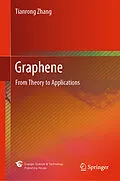This book highlights a comprehensive introduction of graphene and graphene-based two-dimensional nanomaterials, covering topics from their atomic structures, electronic band structures, and fundamental properties to technological applications. The book provides fundamental physics knowledge covering quantum mechanics, the theory of relativity, solid-state physics, and topology geometry necessary to understand electronic band structure of graphene. Other topics including microscopy techniques and preparation methods of graphene are also presented. Adopting an easy-to-read style, the book is a valuable resource for researchers in physics, chemistry, materials science, and engineers who are interested in the field of graphene-based nanomaterials.
Autorentext
Dr. Tianrong ZHANG is a physicist and a science writer. She received her Ph.D. in Theoretical Physics from the University of Texas at Austin. Her research interests include relativity, black hole radiation, Feynman path integration, femtosecond laser, laser detection of crystal properties, high frequency and microwave communication EDA integrated circuit software, etc.
Inhalt
Chapter 1: Discovery of Graphene1. What is graphene
2. Andre Geim's random walk
3. Flying frog and gecko tape
4. Sticky tape led to Nobel Prize
5. Carbon atom family
Chapter 2: Quantum Mechanics
1. Quantum Essences
2. Wave-particle duality
3. Quantum Tunneling effect
4. Spins
5. Identical particles
6. Quantum entanglement
7. Wave functions
8. Uncertainty principle
9. Wave function collapse
10. Probability
Chapter 3: Microscopy Graphene-----Graphene under Microscopy
1. Atom and electron cloud
2. Covalent bond and hybrid orbital
3. A Snapshot of the inside of an atom
4. Microscopy techniques
5. Spectral analysis
6. Angle-resolved photoemission spectroscopy
7. Experimental observation of graphene
Chapter 4: Energy Bands in Crystals
1. Structure determines properties2. What is a crystal?
3. What is electronic band?
4. Conductors, insulators, semiconductors
5. Free electrons in crystals
6. Effective mass and energy band diagram
7. The significance of effective mass
Chapter 5: Electrons Dance in Graphene
1. Band structure of graphene
2. Free-electron approximation
3. Schrodinger equation
4. Special Theory of Relativity
5. Dirac equation
6. Dirac cone
Chapter 6: Quantum Topology
1. Rubber-Sheet Geometry
2. Classic Hall effect
3. Quantum Hall effect
4. Hall effect in graphene
5. Laughlin State
6. Spin dance of electrons
7. Big familyof Hall effects
8. Graphene and topological insulators
Chapter 7: New Materials
1. Preparation of graphene
2. Graphene family nanomaterials
3. Derivatives of graphene
4. Superconductivity and graphene
5. Two-dimensional nanomaterials
6. Three-dimensional graphene
Chapter 8: Applications and Prospect
1. Energy Materials
2. Electronic devices
3. Ultra-thin material that is soft and rigid
4. Lightweight and super strong materials
5. Environmental purification
6. Biomedicine
7. Graphene and glass
